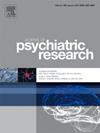Analyzing language ability in first-episode psychosis and their unaffected siblings: A diffusion tensor imaging tract-based spatial statistics analysis study
IF 3.7
2区 医学
Q1 PSYCHIATRY
引用次数: 0
Abstract
Schizophrenia (SZ) is a highly heritable mental disorder, and language dysfunctions play a crucial role in diagnosing it. Although language-related symptoms such as disorganized speech were predicted by the polygenic risk for SZ which emphasized the common genetic liability for the disease, few studies investigated possible white matter integrity abnormalities in the language-related tracts in those at familial high-risk for SZ. Also, their results are not consistent. In this current study, we examined possible aberrations in language-related white matter tracts in patients with first-episode psychosis (FEP, N = 20), their siblings (SIB, N = 20), and healthy controls (CON, N = 20) by applying whole-brain Tract-Based Spatial Statistics and region-of-interest analyses. We also assessed language ability by Thought and Language Index (TLI) using Thematic Apperception Test (TAT) pictures and verbal fluency to see whether the scores of these language tests would predict the differences in these tracts. We found significant alterations in language-related tracts such as inferior longitudinal fasciculus (ILF) and uncinate fasciculus (UF) among three groups and between SIB and CON. We also proved partly their relationship with the language test as indicated by the significant correlation detected between TLI Impoverished thought/language sub-scale and ILF. We could not find any difference between FEP and CON. These results showed that the abnormalities, especially in the ILF and UF, could be important pathophysiological vulnerability indexes of schizophrenia. Further studies are required to understand better the role of language as a possible endophenotype in schizophrenia with larger samples.
分析首发精神病患者及其未受影响的兄弟姐妹的语言能力:基于弥散张量成像束的空间统计分析研究
精神分裂症(SZ)是一种高度遗传性精神障碍,语言功能障碍在诊断中起着至关重要的作用。虽然多基因风险预测了与语言有关的症状,如言语混乱,强调了该疾病的共同遗传责任,但很少有研究调查了家族性高风险人群中可能存在的语言相关束的白质完整性异常。而且,这些研究的结果并不一致。在本研究中,我们通过应用全脑 "基于结构的空间统计"(Tract-Based Spatial Statistics)和 "兴趣区域分析"(region-of-interest analyses),研究了首发精神病患者(FEP,20 人)、其兄弟姐妹(SIB,20 人)和健康对照组(CON,20 人)中可能存在的语言相关白质束畸变。我们还利用主题感知测试(TAT)图片和语言流畅性通过思维和语言指数(TLI)评估了语言能力,以了解这些语言测试的分数是否能预测这些脑束的差异。我们发现语言相关束,如下纵筋束(ILF)和钩状筋束(UF)在三组之间以及在 SIB 和 CON 之间有明显变化。我们还部分证明了它们与语言测试的关系,如 TLI 贫乏思维/语言分量表与 ILF 之间的显著相关性。我们没有发现 FEP 和 CON 之间存在任何差异。这些结果表明,异常(尤其是 ILF 和 UF)可能是精神分裂症的重要病理生理脆弱性指标。要更好地了解语言作为精神分裂症内表型的作用,还需要进行更大规模的研究。
本文章由计算机程序翻译,如有差异,请以英文原文为准。
求助全文
约1分钟内获得全文
求助全文
来源期刊

Journal of psychiatric research
医学-精神病学
CiteScore
7.30
自引率
2.10%
发文量
622
审稿时长
130 days
期刊介绍:
Founded in 1961 to report on the latest work in psychiatry and cognate disciplines, the Journal of Psychiatric Research is dedicated to innovative and timely studies of four important areas of research:
(1) clinical studies of all disciplines relating to psychiatric illness, as well as normal human behaviour, including biochemical, physiological, genetic, environmental, social, psychological and epidemiological factors;
(2) basic studies pertaining to psychiatry in such fields as neuropsychopharmacology, neuroendocrinology, electrophysiology, genetics, experimental psychology and epidemiology;
(3) the growing application of clinical laboratory techniques in psychiatry, including imagery and spectroscopy of the brain, molecular biology and computer sciences;
 求助内容:
求助内容: 应助结果提醒方式:
应助结果提醒方式:


